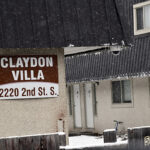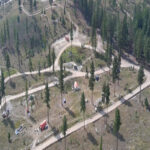Home »

Kimberley begins Mark Creek flume redevelopment process
Alternative approval process (AAP) to begin
The City of Kimberley has begun the public phases of the Mark Creek flume redevelopment.
City officials held the first public meeting on the $4.25 million question March 7 at Centennial Hall, with about 100 residents attending.

Residents were provided with a question and answer sheet, which city staff hoped would cover the bulk of taxpayers’ queries, and Mayor Ron McRae spent the first 35 minutes of the meeting taking people through it.
“This is the first of what we hope will be many opportunities to engage the public,” McRae opened. “Central to this project is the health and safety of the community.”
The flume, which runs through a section of Kimberley’s downtown, beginning at the old Sullivan Mine property, has “emerged as a major issue,” McRae said.
“The flume is beyond its serviceable lifespan and is failing in several points,” he said, adding it was only supposed to have a 50-year lifespan when it was built in 1948, following the worst flood in the city’s history.
After that flood, “the city undertook the straightening and armouring of the channel through town. Approximately 400 meters of the channel was encased in an open concrete flume. The flume was then raised in sections and additional concrete was added to the floor of the flume in 1957, following another major flood in 1956,” the city’s website notes before detailing the problems further.

“The concrete has cracked in many places and has eroded such that there are holes in the floor of the flume. Water is believed to be running under the concrete in places, and the ground is shifting along the channel, placing adjacent homes and businesses at risk. In the spring of 2011, the City of Kimberley installed temporary bracing to shore up a portion of the flume between Wallinger Avenue and St. Mary’s Avenue. To mitigate risks of flooding and land destabilization, planning and design work is being undertaken in advance of a construction project that will redevelop and naturalize Mark Creek.”
The city hopes to obtain federal and provincial government funding for the infrastructure work, leaving it a $1,416,667 share of the cost.
However, in case senior government funding help cannot be obtained, the city is forging ahead with a backup plan to borrowing the entire $4.25 million (Bylaw 2439) from the Municipal Finance Authority, amortized over 25 years. It is estimated the lifespan of the redeveloped flume would be 100 years.
In terms of what this means to the average taxpayer in Kimberley:
If one-third funding only is required, residential taxpayers would see an $8 a year/per $100,000 assessed value of a home/property.
The current average single family residence in Kimberley is valued at $239,563, meaning ratepayers would see an additional $18 on their annual tax bill.
Should the city have to foot the entire bill, the average single family home owner would see a $23/$100,000 increase, or $45 a year for a home valued at $239,563.
In order to move forward, the city must initiate the AAP “as soon as possible to authorize the borrowing,” city literature explained. “Voters will have until April 17 (2012) to show their opposition to the borrowing authorization by submitting a form to city hall attesting to their position. If 10% of electors vote against the borrowing authorization, it will not happen.”
McRae also noted the $4.25 million price tag for the work “is high end.”
A variety of questions were put forward by a few of the people in attendance, including why the city had not been putting money away to pay for an inevitable infrastructure upgrade, asked by Ross Banner.
McRae said the “shortfalls from the past” need to be addressed and the loss of the Teck/Cominco tax base in 2001 “have made funding the depreciation of infrastructure difficult.”
Sid Fletcher asked why the city had waited until “an emergency situation” to address the flume when “it’s known since ’09 or before?” He also questioned why an APP was being considered when there has been time for a referendum, including during the 2011 municipal elections.
“That’s a bit of a difficult one for me to answer given I am recently elected,” McRae said. “I can’t explain the actions of the previous mayor and council. It’s extremely difficult to anticipate all the things that can happen in the city itself.”
The lower one-third of the flume is where problems have arisen, McRae said, and before the support work was done in that area “it was really hard to assess that it was in imminent possible failure.”
As for the APP, McRae said “it’s the most expeditious way for us to address the borrowing needs” and referendums cost “a significant amount of money. The APP is a fair and reasonable way for 10% of the population to register its opposition. He added that a few more than 500 votes would kill the plans.
According to British Columbia’s Community Charter an alternative approval process requires that a local government publish a notice in a newspaper outlining the purposes of a proposed bylaw, agreement, or other matter where the approval of the electors is required. “After the second of two notices is advertised, electors have 30 days in which to advise their local government that in their opinion, the matter is of such significance that a referendum should be held. If more than 10% of the electors hold this opinion, then the local government cannot proceed with the proposed bylaw, agreement, or other matter without holding a referendum.”
Bill Green asked why the city wasn’t considering a redevelopment model that considered flood events larger than ‘a 200-year-flood?’
“Every year there is a one in 200 likelihood it will be exceeded,” he said.
The city’s response was that the federal government asked for a 200-year level if it is to provide funds.
Another gentleman asked what would happen if the APP results in the project being nixed by taxpayers.
“Mayor and council would have to make a decision whether to go to full referendum” and determine from there how to proceed, McRae replied. “At some point that flume will need to be replaced.”
Coun. Albert Hoglund, the lone holdover from the previous council, explained that the federal and provincial governments will also realize “we are serious” if the city takes steps to borrow the money needed.
“We’ve had many conversations with our MP and MLA and they are well aware of it,” he said.
The issue of compensation to property owners near the flume was broached by Dan Schellenberg, who lives near the flume.
“I am under the impression my property will be affected because no one has come to talk me,” he said, adding with a laugh he hopes “no Ark” is needed. He then asked if property owners would be compensated if anything occurred during redevelopment work.
McRae’s answer was succinct. “Yes.” He later said compensation is considered to “some” degree in the total price tag of the project.
The city’s literature on the proposal notes: “No buildings are in imminent danger of falling into the creek. Temporary supports are in place to reinforce weak areas of the flume walls. The City’s goal is to begin redevelopment of the Mark Creek flume before an emergency situation develops. The City is working with our Emergency Management Committee and is monitoring the situation closely. Residents in the area will be notified immediately if heightened risk develops. As always, if there is a large snowpack and a quick melt, there is a risk of flooding.”
Finally, the idea of making the flume redevelopment tourism friendly, where it could become an attraction for the city, was put forward.
“We are looking at all aspects. There is a good opportunity here to have an end product” that will be economically beneficial to Kimberley, McRae said.
“The first priority of Mark Creek redevelopment is to protect public safety and private property from spring floods. If incremental enhancements are made to support recreational activities, incremental funding will come from sources other than municipal taxpayer dollars,” the city handout adds.
Should all go according to plan, work on the flume is expected to take about three years, the city explains.
“The redevelopment project will take place through three phases and be implemented over three years. Ongoing information updates will be provided on the city website and public meetings will be held at key intervals. Work will move upstream from the bottom toward the top of the flume.
As to what Mark Creek may look like when it is fixed, the city states, “The vision is to naturalize Mark Creek wherever possible, to mimic natural channel conditions and achieve lower water velocities and a longer service life. This will also improve aquatic habitat. Where space permits, riparian plants will be added along the banks to provide shade. In some places, engineered structures may be necessary to avoid compromising utilities and infrastructure and ensure safe passage of flows. The city will hold more public meetings in the future to solicit community input once a preliminary design is available.”
For more detailed information on the project, process, details and bylaw go to:
https://kimberley.civicweb.net/Documents/DocumentDisplay.aspx?ID=1461
https://kimberley.civicweb.net/Documents/DocumentDisplay.aspx?ID=1462
https://www.city.kimberley.bc.ca/files/%7BACC62AF1-E78E-45CA-9A91-F21CAE9FBBC9%7DFlume%20Bylaw.pdf
https://kimberley.civicweb.net/Documents/DocumentDisplay.aspx?ID=1460
https://kimberley.civicweb.net/Documents/DocumentDisplay.aspx?ID=1458
https://kimberley.civicweb.net/Documents/DocumentDisplay.aspx?ID=1459
For more on the alternative approval process please check out: https://www.cscd.gov.bc.ca/lgd/gov_structure/community_charter/governance/alternative_approval_process.htm
Ian Cobb/e-KNOW







